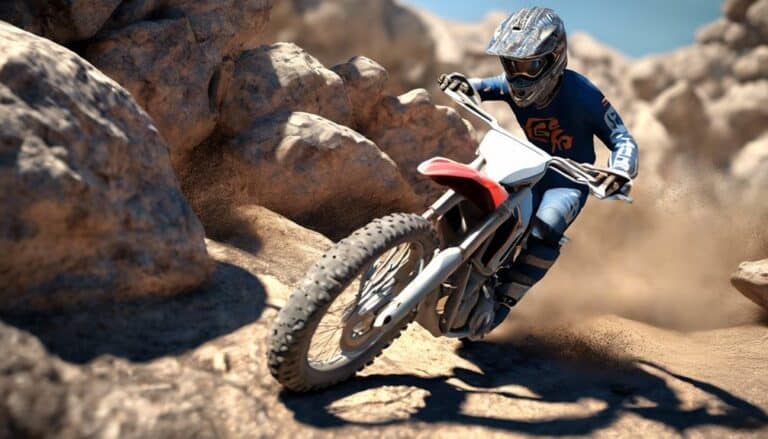Imagine yourself traversing a dirt bike through a winding trail, approaching a sharp turn where the terrain suddenly changes from smooth to rocky. Just like adjusting your speed to match the terrain, honing your braking skills for different surfaces is key to a safe and enjoyable ride.
But how can you effectively enhance your braking techniques to handle various terrains with confidence? Let's explore some essential strategies that can elevate your braking prowess and enrich your overall dirt biking experience.
Key Takeaways
- Master attack position and weight distribution for control on varied terrains.
- Utilize gear management and downshifting to enhance braking efficiency.
- Maintain stability with strategic foot placement and balance front/rear brake usage.
- Adapt braking techniques to different terrains for improved control and versatility.
Attack Position and Braking Techniques
Mastering the attack position and its associated braking techniques is fundamental for dirt bike riders looking to enhance control and responsiveness across various terrains. When it comes to braking, the attack position plays a significant role in optimizing your body alignment for improved control. By adopting this stance, you position yourself in a way that supports stability and balance, especially during braking maneuvers.
Understanding how your body positioning affects brake performance is key to mastering braking skills on different terrains. The attack position allows you to distribute your weight effectively, maximizing the bike's traction and enhancing your ability to adjust to changing terrain conditions swiftly. This riding technique not only boosts your control over the bike but also keeps you prepared for any obstacles that may come your way.
Mastering Downshifting for Better Braking
Optimizing your downshifting technique is essential for enhancing your dirt bike braking proficiency on various terrains. Downshifting before braking allows you to leverage engine braking, utilizing the resistance of the engine to slow down the bike effectively. Proper downshifting involves syncing engine RPM with wheel speed for smooth deceleration, contributing to better control and stability. Understanding the connection between gear selection and braking is vital for maintaining stability across different terrains. By mastering downshifting, you can manage your speed more efficiently, anticipate obstacles, and prepare for upcoming turns during braking, ultimately enhancing your riding performance.
| Benefits of Mastering Downshifting | |
|---|---|
| 1. Enhanced braking efficiency | |
| 2. Reduced wear on brake components | |
| 3. Improved riding performance | |
| 4. Better control and stability |
Optimal Foot Placement for Braking
To enhance your dirt bike braking proficiency on different terrains, ensuring ideal foot placement is essential for maintaining stability and control during braking maneuvers. Proper foot placement involves sliding your foot slightly forward with a locked knee, promoting improved balance when applying brakes.
Here are some key points to keep in mind for ideal foot placement:
- Correct foot positioning enhances stability and control on diverse terrains.
- Maintaining a stable foot position supports effective weight transfer and reduces the risk of skidding.
- Gripping the bike with your knees while maintaining proper foot placement is vital for control and stability during braking.
- Strategic foot placement can optimize braking efficiency and aid in overall bike handling.
- Ensuring your foot is in the right position allows you to adjust weight distribution effectively, enhancing control over the bike's movements.
Balancing Front and Rear Brake Usage
Achieving a harmonious balance between your front and rear brake usage is fundamental for maintaining stability and control while braking across different terrains. When applying brakes on your dirt bike, understanding the dynamics between the front and rear brakes is essential for effective braking. The table below outlines key points to consider when balancing front and rear brake usage:
| Aspect | Importance |
|---|---|
| Brakes | Essential components for controlled braking |
| Body Positioning | Influences weight distribution for stability |
| Braking Techniques | Varied methods for different terrains |
| Control and Stability | Maintaining balance for safe braking |
| Stopping Power | Optimizing braking efficiency |
Proper balance between the front and rear brakes ensures that stopping power is optimized while maintaining control and stability. By mastering the art of applying both brakes in sync with your body positioning, you enhance your riding skills and overall control of the bike. Remember, effective braking is not just about stopping; it's about doing so with finesse and skill.
Braking Strategies for Various Terrains
When traversing different terrains on your dirt bike, adapting your braking strategies becomes pivotal to maintaining control and stability. To navigate diverse landscapes effectively, consider the following braking techniques tailored to various terrains:
- Adjust braking technique: Modify your braking approach for sand, mud, rocks, and forests to guarantee stability and control.
- Practice obstacle course drills: Engage in drills to enhance adaptability and improve bike handling skills across different terrains.
- Utilize quick reflexes: Slow down in forested areas, employing quick reflexes and slower speeds to navigate challenging terrain effectively.
- Manage rear brake: Reduce rear brake usage on sand and mud terrains due to decreased traction, while skillfully handle rocks and roots to overcome obstacles.
- Enhance adaptability: Riding on diverse terrains demands adaptability to guarantee control, stability, and versatility in varying riding conditions.
Conclusion
As you navigate through different terrains on your dirt bike, remember that mastering braking skills is key to your success. By honing techniques like the attack position, downshifting, and proper foot placement, you can enhance your control and stability.
Balancing front and rear brake usage, along with consistent practice, will guarantee you're prepared for any challenge ahead. So keep pushing yourself, keep learning, and soon you'll be braking like a pro on any terrain you encounter.

